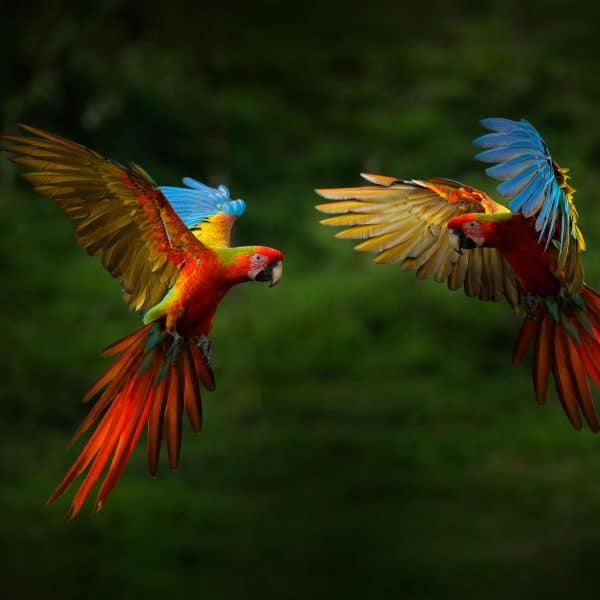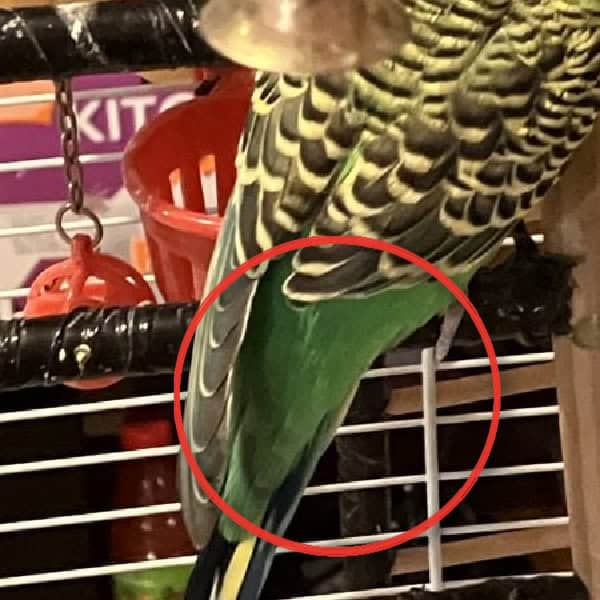If you have a parrot that is self-destructive to his feathers start by taking a good look at his environment from a bird’s point of view. Is he located in front of a window?
If so you should place the bird where it still has a view but not directly in front of the window.
Parrots do not understand that they are in a home where the predators cannot get to them, so things they see outside are very frightening for them.
You will also want to cover the back half of the cage (say against a wall) to give the bird a sense of security when perched toward the back of the cage.
This also provides much-needed privacy for preening, napping, and masturbation.
It is important for your parrot to have the privacy of his choice. Being on display twenty-four hours a day is very stressful and may cause feather-destruction habits.
You also want to place a perch high up in the back corner of the cage with several toys around and in front of the perch, so that when the parrot is back there he can watch his surrounding undetected as he would in the wild.
WORKING TOYS
Working toys are also important. Your parrot should have at least three toys in the cage that make them work for their food. Toy manufacturers have come out with several wonderful working toys, plus you can make some right from home such as using an old pill bottle, washed, and filled with food. Fill a cotton sock and hang in cage or a small cardboard box or egg carton filled. Working toys should be rotated with other working toys so the parrot does not become bored.
CHEWING
Some birds will only bother their feathers during springtime because this is a time of year when they would be building a nest and raising babies, so we need to increase the amount of things for them to chew during these times. If you know that your parrot picks badly once the weather gets warmer then start preparing the cage prior to the warm months by packing it with different shapes and textures for your parrot to explore and shred.
This will deter the parrot from chewing on himself. Use several different types of household items such as; adding machine tape, corn husks, paper towels, cotton socks, willow tree branches, grapevines wreaths, cardboard, TV guide, newspaper, tissue paper, Dixie cups, wooden spoons, whisk broom, raffia, Popsicle sticks, tongue depressors, shoe laces, straws, and also weave their leafy greens into the cage bars instead of just placing them in a bowl in front of them. Place the greens all around the cage, not worrying whether or not there is a perch in front of them.
SLEEP
Many parrots come from areas close to the equator and they receive twelve hours of both night and day. Some parrots are a little more nocturnal, with a parrot such as an African gray you would want to give them ten hours as opposed to twelve. Where a cockatoo requires a good twelve hours of quiet uninterrupted darkness each night. If your parrot’s cage is located in a family area I suggest buying a smaller sleeping cage that you can place in a quiet area for nighttime.
EXERCISE
Sitting on a play gym is not exercise. We need to take a better look at our birds’ daily habits and incorporate more exercise into their routines. You can have your bird go up and down stairs in your home, you can gently swing them around to make them flap their wings, or you can even toss them in the air (with proper wing clips, if the cut is too short I do not recommend this) and let them fly gently down, doing this several times in a row. You can also run around with the bird above your head allowing them to flap their wings vigorously. You can take them outside and let them climb a small tree up and down, or run in the yard, supervised of course.
.
FLIGHT
There is also the option of allowing your birds flight, although this can be dangerous and you need to weigh the benefits and dangers of having a flighted parrot. When a parrot is properly exercised each day they are less likely to be problematic in the household. So sit down with the family and discuss an exercise routine for the parrot that will fit into the family’s routines. Children can be included even if the parrot does not care for them. You can have your children work with the bird inside the cage by playing music loudly and having the kids dance with the parrot. This is great exercise for both the kids and the bird. Always supervise small children with parrots.
Your parrot should receive at least two to four hours of “out of cage time” a day with at least one hour of one-on-one time with you. This is time that you spend directly with your parrot each day. This time can be broken up throughout the day it need not be all at once. You will want to be careful not to give this attention when the bird is feather picking, you will want to give this attention when the bird is being good.
If the bird is picking, distract his attention away from his feathers before you go and give attention to him. This is very important as we tend to want to tell the bird no or go over and stop them. Instead make a noise by either knocking or clapping to distract, then praise the bird the moment it stops, and give attention. Lengthen the time between the praise and attention each time. Eventually, the destruction will be less and less if you are consistent.
Okay let’s recap; Evaluate cage location and move cage if necessary, sleep 10-12 hours depending on breed, shower daily even several times a day, working for food, toys that are easily shredded with different textures, and of course EXERCISE, EXERCISE, EXERCISE!!!!!!
Courtesy of : Michelle Karras, The Polite Parrot
 The Traveling BirdJune 26, 2025Can You Name 5 Parrot Species That Are Living Wild in the USA?
The Traveling BirdJune 26, 2025Can You Name 5 Parrot Species That Are Living Wild in the USA? Bird BehaviorJune 26, 2025How is it Parrots Are Problem Solvers Social Animals and Even Use Tools?
Bird BehaviorJune 26, 2025How is it Parrots Are Problem Solvers Social Animals and Even Use Tools? Bird & Parrot AnatomyJune 25, 2025How a Tiny Chemical Modification Makes Parrots Nature’s Living Paintings
Bird & Parrot AnatomyJune 25, 2025How a Tiny Chemical Modification Makes Parrots Nature’s Living Paintings PigeonsJune 20, 2025How Do Parrots Thrive in Cities Outside Their Native Habitats?
PigeonsJune 20, 2025How Do Parrots Thrive in Cities Outside Their Native Habitats?



